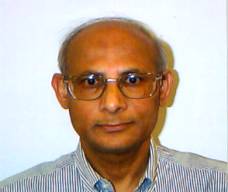SUBAL C. BISHAYEE
Associate Professor• M.Sc.
Calcutta University, 1969
• Ph.D.
Calcutta University, 1975
Research Interests
• Receptor
tyrosine kinases
• Dietary
supplements and cancer

SUBAL C. BISHAYEEAssociate Professor• M.Sc.
Calcutta University, 1969 Research Interests • Receptor
tyrosine kinases |
 |
Signal transduction by the epidermal growth factor receptor One of the major interests of our laboratory is to understand the molecular basis of signal transduction mediated by the epidermal growth factor receptor (EGFR). EGFR is a transmembrane protein with intrinsic tyrosine kinase activity. The receptor contains multiple N-linked glycosylation sites in its extracellular region subdivided in four. Core glycosylation is needed to induce a conformation critical for EGF binding. Ligand binding activates the kinase by converting the monomeric receptor to its dimeric state. We have recently demonstrated that a naturally occurring truncated EGFR expressed in human glioblastomas is constitutively active due to its ligand-independent dimerization. This results in deregulation of signaling leading to oncogenesis. Interestingly, such receptor-receptor self-association, like EGF-induced dimerization, is also highly dependent on glycosylation. We are actively pursuing by in vitro mutagenesis to identify the glycosylation sites in the normal and oncogenic EGFRs that are important in maturation and proper folding of the receptor to its active conformation. In addition, we are also studying the roles of chaperones and oxidoreductases in the maturation of the EGFR. Such studies will not only allow us to understand the structure-function relationship of an important receptor involved in oncogenesis but will also pave the way to control the activation of the aberrant receptor expressed in cancer cells.
We have developed a novel antibody directed to an unphosphorylated peptide corresponding to a site located close to the kinase domain of the platelet-derived growth factor ▀-receptor (PDGFR▀ This antibody, AbP2, recognizes the activated receptor and hence phosphorylated receptor and not the unphosphorylated receptor. We have used this antibody to demonstrate recently that the C-terminal tail of the PDGFR▀ is involved in autoinhibition of its tyrosine kinase activity. Interestingly, AbP2 also recognizes the activated epidermal growth factor receptor (EGFR) and not the dormant receptor. The antibody is also being used in understanding the role of certain epitopes in EGFR function. As aberrant expression of the activated EGFR as well as PDGFR▀ is associated with and causal for oncogenesis, this antibody has the potential use as a diagnostic tool in early detection of certain forms of cancer.
Dietary supplements in cancer prevention A number of naturally occurring dietary factors are known to have anti-proliferative effect on some tumor cells. We are exploring the efficacy of two such compounds, namely curcumin (diferuloyl methane), the major active pigment of turmeric, and lycopene (f, f -carotene), present in tomato. Preliminary studies suggest that some cancer cell lines are highly susceptible to curcumin whereas others are not. In addition, it appears that there is a considerable reduction in the epidermal growth factor receptor (EGFR) population in circumin-treated cells. Since EGFR over-expression is associated with oncogenesis, our laboratory is actively pursuing if there is any correlation between circumin-induced cell death and EGFR degradation.
Panneerselvam, K., Reitz, H., Khan, S.A., and Bishayee, S. A conformation-specific anti-peptide antibody to the ▀-type platelet-derived growth factor receptor also recognizes the activated epidermal growth factor receptor. J. Biol. Chem., 270:7975-7979, 1995.
Panneerselvam, K., Raj, S., Das, M., and Bishayee, S. Characterization of a novel epidermal growth factor receptor-related 200-kDa tyrosine kinase in tumor cells. Eur. J. Biochem., 230:951-957, 1995.
Bishayee, A., Beguinot, L., and Bishayee, S. Phosphorylation of tyrosine 992, 1068 and 1086 is required for conformational change of the human epidermal growth factor receptor C-terminal tail. Mol. Biol. Cell, 10:525-536, 1999.
Bishayee, S. Assessment of the role of growth factors and their receptors in cell proliferation. In ôCell Growth, Differentiation and Senescence - A Practical Approachö ed. George P. Studzinski (Oxford University Press) pp95-123, 1999.
Bishayee, A., Beguinot, L., and Bishayee, S.. Conformational analysis of the phosphorylated epidermal growth factor receptor. Bioscience Reports, 19:397-402, 2000.
Bishayee, S. Role of conformational alteration in the epidermal growth factor receptor function. Biochemical Pharmacology, 60:1217-1223, 2000.
Fernandes, H., Cohen, S., and Bishayee, S. Glycosylation-induced conformational modification positively regulates receptor-receptor association: A study with an aberrant epidermal growth factor receptor (EGFRviii/?EGFR) expressed in cancer cells. J. Biol. Chem, 276:5375-5383, 2001.
Chiara, F., Bishayee, S., Heldin, C-H., and Demoulin, J-B. Autoinhibition of the platelet-derived growth factor ▀-receptor tyrosine kinase by its C-terminal tail. J. Biol. Chem., 279:19732-19738, 2004.